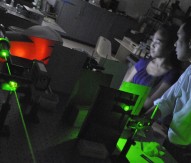
Pioneering X-ray diffraction technique created
A new X-ray diffraction technique that works on single organic molecules has been developed by a team of international researchers. The scientists hope that it can be used to work out protein structures and potentially investigate entire living cells.
A team of researchers from Europe and North America began with an ultracold beam of 2.5-diiodobenzonitrile molecules in polarised laser light. Each molecule contains two iodine atoms that are opposite benzene rings. The electric field of the laser light causes the molecules to line up along the axis defined by these two atoms.
The beam is then passed through pulses from the Linac Coherent Light Source (LCLS), which is the world’s most powerful X-ray free electron laser. Powerful electrodes placed around the interaction point allow the team to collect and detect iodine atoms ejected from the molecules. By finding the source of where these atoms were expelled from the molecules, the team confirmed that the molecules were properly aligned.
X-ray diffraction determines molecular structures, but the diffraction signal from individual molecules is weak. Scientists have therefore developed two leading ways to amplify it: by incorporating large numbers of the molecules into a regular crystalline array, or by boosting the X-ray exposure time and/or intensity which could alter or destroy the molecule.
Diffracted X-rays from multiple pulses were combined to create a diffraction pattern that was then used to estimate the distance between the two iodine atoms. The result was an iodine–iodine separation of 800pm, whereas the known distance is 700pm. The researchers said that this is because the wavelength of the X-rays was 620pm, which made it difficult to resolve distances finer than this.
Since then, wavelengths of 100–200pm have become available at the LCLS and will soon be available at the European XFEL, opening in Hamburg next year. The researchers are hoping to use these shorter wavelengths to compile detailed structural information on larger biochemical molecules, including peptides.
The research is published in Physical Review Letters.






